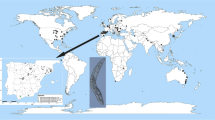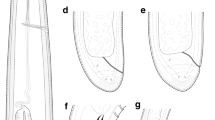Abstract
The nematode worm Scottnema lindsayae (Cephalobidae) was found near the base of the Beardmore Glacier in the Transantarctic Mountains 83.48°S, over 5° further south than previously recorded. Identification was confirmed using morphological analyses of males, females and juvenile stages, and by DNA sequencing of the ITS1 region of the ribosomal RNA tandem repeat unit. These data revealed no discernable morphological or ITS rDNA sequence variation between the extreme southern population of S. lindsayae and disparate populations from the McMurdo Dry Valleys in south Victoria Land (77–78°S). Based on these results, we suggest that broadcast dispersal, with accompanying high rates of gene flow, establish the extreme southern distribution of the phylum Nematoda. High abundance, low rates of diversification and lack of an apparent biogeographic structure across latitudinal and environmental gradients implies that their presence in simple Antarctic soil ecosystems is stable, so long as physical and biological controls on their distributions remain within viable parameters. Recent evidence that S. lindsayae populations are in decline suggests that their high dispersal rates are insufficient to buffer current, unfavorable environmental changes and may foreshadow longer-term ecosystem disruption.

Similar content being viewed by others
References
Adams BJ (1998) Species concepts and the evolutionary paradigm in modern nematology. J Nematol 30:1–21
Adams BJ (2001) The species delimitation uncertainty principle. J Nematol 33:153–160
Adams BJ, Burnell AM, Powers TO (1998) A phylogenetic analysis of Heterorhabditis (Nemata: Rhabditidae) based on internal transcribed spacer 1 DNA sequence data. J Nematol 30:22–39
Adams BJ, Bardgett RD, Ayres E, Wall DH, Aislabie J, Bamforth S, Bargagli R, Cary C, Cavacini P, Connell L, Convey P, Fell JW, Frati F, Hogg I, Newsham K, O’Donnell A, Russell N, Seppelt RD, Stevens MI (2006) Diversity and distribution of Victoria Land biota. Soil Biol Biochem 38:3003–3018
Ashworth AC, Kuschel G (2003) Fossil weevils (Coleoptera: Curculionidae) from latitude 85[deg]S Antarctica. Palaeogeogr Palaeoclimatol Palaeoecol 191:191–202
Askin RA (1992) Late Cretaceous-Early Tertiary Antarctic outcrop evidence for past vegetation and climates. In: Kennett JP, Warnke DA (eds) The Antarctic paleoenvironment: a perspective on global change. American Geophysical Union, Washington, pp 61–73
Barrett JE, Virginia RA, Wall DH, Parsons AN, Powers LE, Burkins MB (2004) Variation in biogeochemistry and soil biodiversity across spatial scales in a polar desert ecosystem. Ecology 85:3105–3118
Barrett JE, Virginia RA, Parsons AN, Wall DH (2005) Potential soil organic matter turnover in Taylor Valley, Antarctica. Arct Antarct Alp Res 37:107–116
Barrett JE, Virginia RA, Wall DH, Cary SC, Adams BJ, Aislabie JM (2006) Co-variation in soil biodiversity and biogeochemistry in Northern and Southern Victoria Land, Antarctica. Antarct Sci (in press)
Cherry T, Szalanski AL, Todd TC, Powers TO (1997) The internal transcribed spacer region of Belonolaimus (Nemata: Belonolaimidae). J Nematol 29:23–29
Clow GD, McKay CP, Simmons Jr GM, Wharton Jr RW (1987) Climatological observations and predicted sublimation rates at Lake Hoare, Antarctica. J Clim 1:715–728
Courtright EM, Wall DH, Virginia RA, Frisse LM, Vida JT, Thomas WK (2000) Nuclear and mitochondrial DNA sequence diversity in the Antarctic nematode Scottnema lindsayae. J Nematol 32:143–153
Courtright EM, Wall DH, Virginia RA (2001) Determining habitat suitability for soil invertebrates in an extreme environment: the McMurdo Dry Valleys, Antarctica. Antarct Sci 13:9–17
Crowe JH, Madin KAC (1975) Anhydrobiosis in nematodes—evaporative water-loss and survival. J Exp Zool 193:323–333
Demeure Y, Freckman DW, Van Gundy SD (1979) In vitro response of four species of nematodes to desiccation and discussion of this and related phenomena. Revue Nematol 2:203–210
Doran PT, McKay CP, Clow GD, Dana GL, Fountain AG, Nylen T, Lyons WB (2002a) Valley floor climate observations from the McMurdo dry valleys, Antarctica, 1986–2000. J Geophys Res 107:4772–4784
Doran PT, Priscu JC, Lyons WB, Walsh JE, Fountain AG, McKnight DM, Moorhead DL, Virginia RA, Wall DH, Clow GD, Fritsen CH, McKay CP, Parsons AN (2002b) Antarctic climate cooling and terrestrial ecosystem response. Nature 415:517–520
Finlay BJ (2002) Global dispersal of free-living microbial eukaryote species. Science 296:1061–1063
Finlay BJ, Fenchel T (2004) Cosmopolitan metapopulations of free-living microbial eukaryotes. Protist 155:237–244
Fleming RF, Barron JA (1996) Evidence of Pliocene Nothofagus in Antarctica from Pliocene marine sedimentary deposits. Mar Micropaleontol 27:227–236
Freckman DW, Virginia RA (1993) Extraction of nematodes from Dry Valley Antarctic soils. Polar Biol 13:483–487
Freckman DW, Virginia RA (1997) Low-diversity Antarctic soil nematode communities: distribution and response to disturbance. Ecology 78:363–369
Freckman DW, Virginia RA (1998) Soil biodiversity and community structure in the McMurdo Dry Valleys, Antarctica. In: Priscu JC (eds) Ecosystem dynamics in a polar desert The McMurdo Dry Valleys, Antarctica. American Geophysical Union, Washington, pp 323–336
Gooseff MN, Barrett JE, Doran PT, Fountain AG, Lyons WB, Parsons AN, Porazinska DL, Virginia RA, Wall DH (2003) Snow-patch influence on soil biogeochemical processes and invertebrate distribution in the McMurdo Dry Valleys, Antarctica. Arct Antarct Alp Res 35:91–99
Johnson SR, Ferris JM, Ferris VR (1974) Nematode community structure of forest woodlots: III. Ordinations of taxonomic groups and biomass. J Nematol 6:118–126
King JC, Turner J (1997) Antarctic meterorology and climatology. Cambridge University Press, New York
Marchant DR, Lewis AR, Phillips WM, Moore EJ, Souchez RA, Denton GH, Sugden DE, Potter N, Landis GP (2002) Formation of patterned ground and sublimation till over Miocene glacier ice in Beacon Valley, southern Victoria Land, Antarctica. Geol Soc Am Bull 114:718–730
Moorhead DL, Wall DH, Virginia RA, Parsons AN (2002) Distribution and life-cycle of Scottnema lindsayae (Nematoda) in Antarctic soils: a modeling analysis of temperature responses. Polar Biol 25:118–125
Mouratov S, Lahav I, Barness G, Steinberger Y (2001) Preliminary study of the soil nematode community at Machu Picchu Station, King George Island, Antarctica. Polar Biol 24:545–548
Nadler SA, Adams BJ, Lyons ET, DeLong RL, Melin SR (2000) Molecular and morphometric evidence for separate species of Uncinaria (Nematoda : Ancylostomatidae) in California sea lions and northern fur seals: Hypothesis testing supplants verification. J Parasitol 86:1099–1106
Nguyen KB, Maruniak J, Adams BJ (2001) The diagnostic and phylogenetic utility of the rDNA internal transcribed spacer sequences of Steinernema. J Nematol 33:73–82
Nkem JN, Wall DH, Virginia RA, Barrett JE, Broos EJ, Porazinska DL, Adams BJ (2006) Wind dispersal of soil invertebrates in the McMurdo Dry Valleys, Antarctica. Polar Biol 29:346–352
Oliver RL (1972) Geology of an area near the mouth of Beardmore Glacier, Ross Dependency. Antarctic geology and geophysics: Symposium on Antarctic Geology and Solid Earth Geophysics, 6–15 August 1970
Overhoff A, Freckman DW, Virginia RA (1993) Life-cycle of the microbivorous Antarctic Dry Valley nematode Scottnema lindsayae (Timm 1971). Polar Biol 13:151–156
Parish TR, Bromwich DH (1987) The surface wind field over the Antarctic ice sheets. Nature 328:51–54
Porazinska DL, Wall DH (2002) Population age structure of nematodes in the Antarctic Dry Valleys: perspectives on time, space, and habitat suitability. Arct Antarct Alp Res 34:159–168
Porazinska DL, Wall DH, Virginia RA (2002) Population age structure of nematodes in the Antarctic Dry Valleys: perspectives on time, space, and habitat suitability. Arct Antarct Alp Res 34:159–168
Powers LE, Ho MC, Freckman DW, Virginia RA (1998) Distribution, community structure, and microhabitats of soil invertebrates along an elevational gradient in Taylor Valley, Antarctica. Arct Alp Res 30:133–141
Powers T, Todd T, Burnell A, Murray P, Fleming C, Szalanski A, Adams B, Harris T (1997) The rDNA internal transcribed spacer region as a taxonomic marker for nematodes. J Nematol 29:441–450
Pribil S, Houlahan JE (2003) Life-history strategies associated with local population variability confer regional stability. Proc R Soc Lond Ser B Biol Sci 270:1419–1423
Shishida Y, Ohyama Y (1986) A note on the terrestrial nematodes around Syowa Station, Antarctica. Memoirs of the National Institute of Polar Research 259–260
Stevens MI, Hogg ID (2003) Long-term isolation and recent range expansion from glacial refugia revealed for the endemic springtail Gomphiocephalus hodgsoni from Victoria Land, Antarctica. Mol Ecol 12:2357–2369
Timm RW (1971) Antarctic soil and freshwater nematodes from the McMurdo Sound region. Proc Helminthol Soc Wash 38:42–52
Treonis AM, Wall DH, Virginia RA (1999) Invertebrate biodiversity in Antarctic dry valley soils and sediments. Ecosystems 2:482–492
Treonis AM, Wall DH, Virginia RA (2000) The use of anhydrobiosis by soil nematodes in the Antarctic Dry Valleys. Funct Ecol 14:460–467
Tyndale-Biscoe CH (1960) On the occurrence of life near the Beardmore Glacier, Antarctica. Pac Insects 2:251–253
Vinciguerra MT (1994) Metacrolobus festonatus gen. n. sp. n. and Scottnema lindsayae Timm, 1971 (Nemata, Cephalobidae) from Subantarctic and Antarctic regions with proposal of the new subfamily Metacrobinae. Fundam Appl Nematol 17:175–180
Virginia RA, Wall DH (1999) How soils structure communities in the Antarctic dry valleys. Bioscience 49:973–983
Vrain TC, Wakarchuk DA, Levesque AC, Hamilton RI (1992) Intraspecific rDNA restriction fragment length polymorphism in the Xiphinema americanum group. Fundam Appl Nematol 15:563–574
Wise KAJ, Shoup J (1971) Entomological investigations in Antarctica, 1964–1965 seasons. Pac Insect Monogr 25:27–56
Acknowledgments
We thank Mark St. John, Berry Lyons, John Barrett, Ross Virginia, Chris McKay, members of the BYU Nematode Evolution Lab and three anonymous reviewers for their constructive criticisms of an early draft of this manuscript. Andrew Parsons, Tom Cioppa, Steve Blecker, John Barrett and Jennifer Mercer assisted in the field and laboratory. The staff of the Crary Laboratory, at McMurdo Station, PHI Helicopters, and Rae Spain provided logistical support. This work was funded by the National Science Foundation Grants 00 96250 and 98 13061 to DHW and through logistic support from Antarctica New Zealand to IDH. This project contributes to the Evolution and Biodiversity in Antarctica (EBA) Programme of SCAR.
Author information
Authors and Affiliations
Corresponding author
Rights and permissions
About this article
Cite this article
Adams, B.J., Wall, D.H., Gozel, U. et al. The southernmost worm, Scottnema lindsayae (Nematoda): diversity, dispersal and ecological stability. Polar Biol 30, 809–815 (2007). https://doi.org/10.1007/s00300-006-0241-3
Received:
Revised:
Accepted:
Published:
Issue Date:
DOI: https://doi.org/10.1007/s00300-006-0241-3




